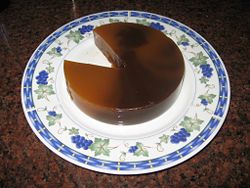This article relies largely or entirely on a single source .(April 2015) |
 Dulce de batata with an addition of chocolate that was sold in a can | |
| Type | Dessert |
|---|---|
| Main ingredients | Sweet potatoes |
Dulce de batata (in Spanish : sweet potato candy, or: sweet potato jam) or doce de batata doce (Portuguese expression with the same meaning) is a traditional Argentine, Brazilian, Paraguayan and Uruguayan dessert, which is made of sweet potatoes. [1] It is a sweet jelly, in Brazil it is known as marrom glacê.
When sold commercially, it is often found canned in flat and round metal cans. In some of the commercial versions of the food, chocolate is added to it.
It is commonly eaten with crackers and/or cheese.